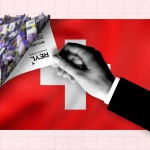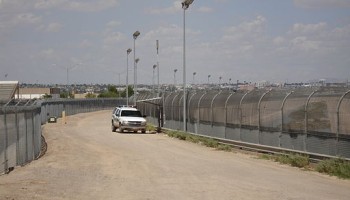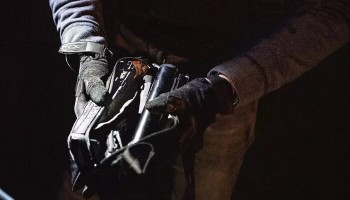Though hardly new to the drug trafficking world – law enforcement first spotted crude versions in the late 1990s – traffickers turned to them in greater number once authorities cracked down on the speedboats used to jet bricks of cocaine up to the US coast throughout the past two decades. Low-riding, relatively slow-moving vessels have proven to be much less conspicuous.
self-propelled, semi-submersible subs (SPSSs) – needed to travel above water to allow their diesel engines to intake air needed for operating. When the Joint Interagency Task Force-South, the international agency that monitors the eastern Pacific and Caribbean, nabbed its first sub in 2006, they called the captured vessel 'Bigfoot,' according to a 2009 New York Times article. Until that moment, such subs had been pure legend, like the sasquatch himself.
But when these subs first cropped up, they travelled like iceburgs, with a small surface area above the water line betraying the 70-plus foot vessel, with ten tons of cocaine – or up to $100 million worth – travelling underneath. Those ships – Now, thanks to the adoption of battery power, the new fleet is fully-submersible. They can avoid above-water exposure and can run for hundreds of miles (albeit slowly) without relying on the engine at all. Battery power also eliminates their vulnerability to infrared detection, because it eliminates the heat of exhaust explusion. When authorities appear, they can dive even deeper to more than 30 feet under water to evade detection.
Usually built from fiberglass, these vessels appear quite rustic, but inside they are a surprising fusion of high- and low- tech.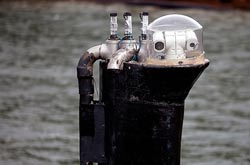 A captured sub's periscope includes two cameras, one for daylight and one that works when the sub is submerged. Photo: Time Magazine
A captured sub's periscope includes two cameras, one for daylight and one that works when the sub is submerged. Photo: Time Magazine
Their cabins are usually equipped with not only periscopes using cameras but also radios and GPS devices, and some are even air-conditioned. Still, it's not a pleasant way to cross the sea. The ride can be rough, and the conditions inside "horrendous," the Department of Homeland Security said in an announcement about its own model submarine. "The small crews of 3 or 4 have little to eat, poor air quality, no toilet facilities, operate with little rest until they reach their destination, and are sometimes watched over by an armed guard."
The first of these new, fully-submersible vessels was discovered in 2010 by Ecuadorian police in a remote swamp just south of the Colombian border. It was in a makeshift work camp built to accomodate 50 people, and the fiberglass craft was almost 100 feet long and could hold six crew members and ten tons of cocaine, according to reports by National Geographic.
Due to increased border patrol in the United States and in Central America, smugglers have increasingly turned to maritime routes for drug trafficking, according to reports by Europol and other international agencies. Of all cocaine trafficked to the United States, more than 80%, or 780 tons, travels by sea, according to US military authorities. And even European-bound cocaine is now travelling by sea through the Caribbean before being flown to Spain, the UNODC noted in this year's World Drug Report.
Though the JIATF has intercepted TK semi-submersibles in recent years - at least five of which in the increasingly-trafficked Caribbean area, no fully submersible vessels have yet been captured at sea. And with visual and infrared detection useless against them, to spot such subs in the ocean, enforcement agencies may be forced to rely on satellite and sonar rechnology, both of which are expensive and time-consuming.
But one recent development works in the favor of the authorities. Since the Drug Trafficking Vessel Interdiction Act passed in 2008, U.S. authorities can now criminally prosecute submarine crews simply for operating a semi- or fully- submersible submarine. Before that law was passed, a significant advantage to submarine trafficking was the ease of destroying evidence inside. Most submarines are equipped with a valve that can quickly flood and sink the vessel if it is spotted, so if authorities were closing in, crews would abandon, or "scuttle" their ships, and avoid prosecution as the evidence sank with the submarine. Now a lack of physical evidence doesn't hinder prosecution. "The passage of the DTVIA significantly aided law enforcement efforts to deliver consequences to those who put to sea in these conveyances," the legal advisor for JIATF said earlier this month.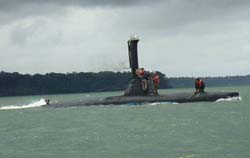 The newest subs are battery powered and fully submersible like this one captured in Colombia in 2011
The newest subs are battery powered and fully submersible like this one captured in Colombia in 2011
A charge under the Drug Trafficking Vessel Interdiction Act of 2008 carries a sentence of up to fifteen years in jail, and at least twenty such cases have been successfully prosecuted over the past four years. But the Act has also been criticized for its boldness, and a 2011 appeal in Florida even challenged the constitutionality of the law. Still, US military officials insist it is necessary, and invoke the fear of more malevolent submarine uses in the future to underscore its importance.
"The organizations known to be funding SPSSs and FSVs are not in business to be nice guys and improve the communities in which they operate; they are motivated by profit," said JIATFS spokesperson Jody Draves. "While their cargo product of choice right now is cocaine, in the future, it could include something even more profitable and more threatening to regional and U.S. national security."
US Lawmakers are similarly concerned. In September of this year,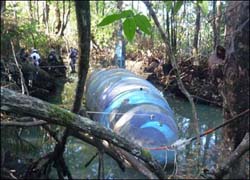 Narco groups have manufactured self-propelled fully submersible submarines like this one discovered in the jungles of Ecuador in 2011
Narco groups have manufactured self-propelled fully submersible submarines like this one discovered in the jungles of Ecuador in 2011
the congressional drug-control caucus released a report on security concerns in the Caribbean. “The recent spike in the use of drug-trafficking submarines there shows the lengths smugglers are taking to get their product to U.S. shores through the area," said Senator Charless Grassley, a chairman of the caucus, in a press release.
The report criticizes disjointed US policies for supporting drug enforcement in certain
regions only to drive trafficking to other regions less equipped to fight it. It calls for a more integrated approach to security in the Americas, and warns that without one a security crisis is inevitable, saying "we must be prepared as the 'balloon effect' inevitably moves drug trafficking routes back to the Caribbean."
By Eliza Ronalds-Hannon


